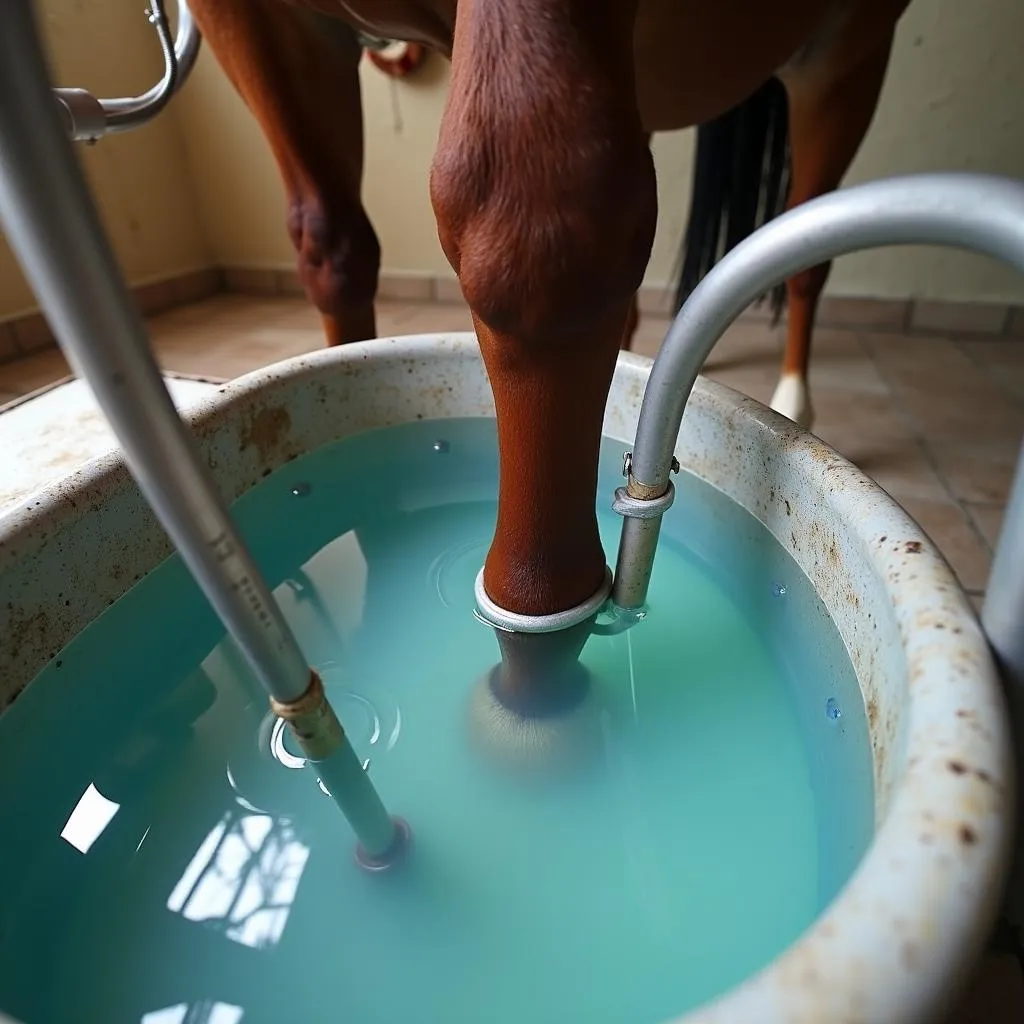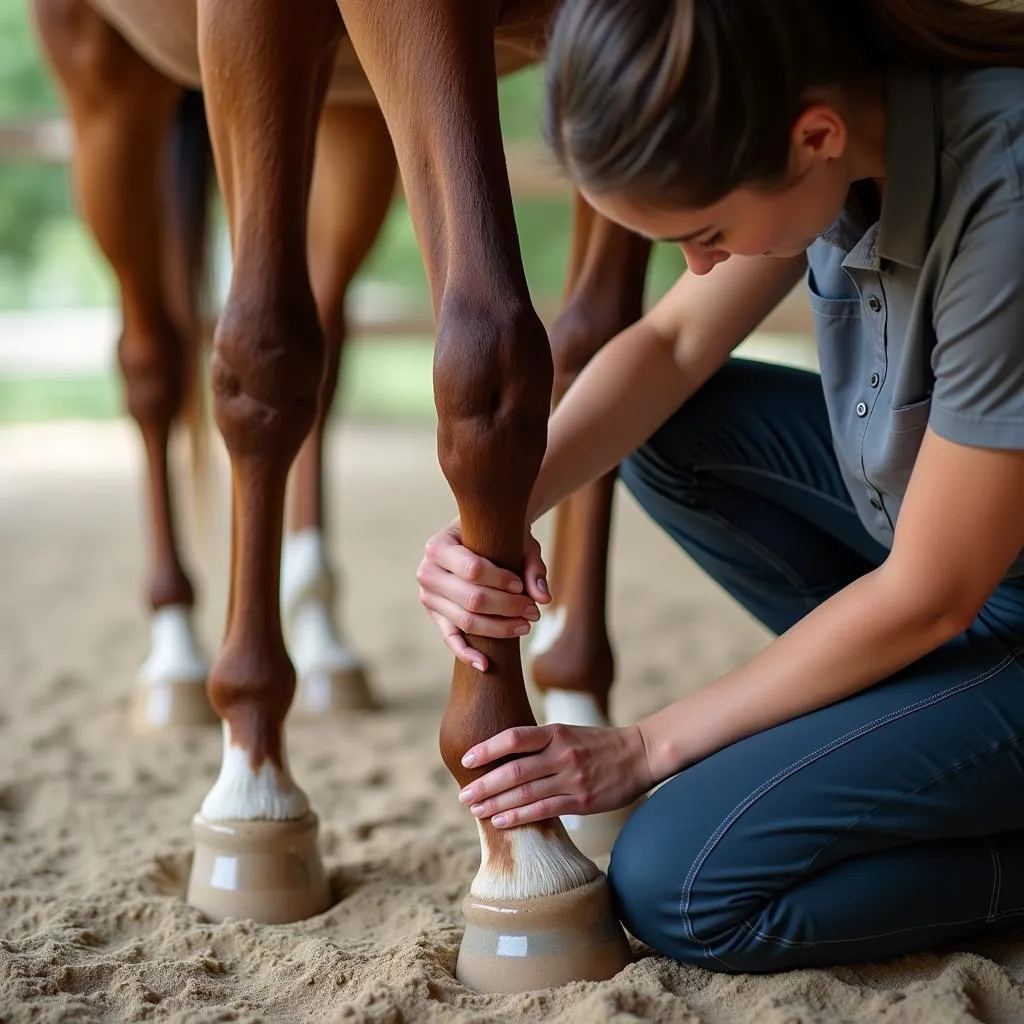Equine Spa therapy is becoming increasingly popular as more horse owners recognize the therapeutic benefits it offers their equine companions. But what exactly is an equine spa, and what are the advantages of incorporating it into your horse’s wellness routine?
Understanding Equine Spa Therapy
Equine spa treatments, much like their human counterparts, focus on relaxation and rejuvenation. These therapies primarily center around soothing the horse’s legs and hooves, promoting circulation, and easing muscle tension. While specific treatments can vary between facilities, the core principles remain consistent: providing a spa-like experience designed to enhance the horse’s overall well-being.
 Horse Leg in Spa Treatment
Horse Leg in Spa Treatment
The Advantages of Equine Spa Treatments
Equine spa therapy offers a range of benefits for horses of all disciplines and ages. Let’s delve into some of the key advantages:
- Enhanced Circulation: The warm water and specialized massage techniques used in equine spas effectively improve blood circulation in the horse’s legs and hooves. This increased blood flow delivers vital nutrients and oxygen to the tissues, aiding in healing and reducing inflammation.
- Reduced Inflammation and Swelling: Many equine spa treatments incorporate cold therapy, which is particularly beneficial in reducing inflammation and swelling, especially in the lower limbs. This can be particularly helpful for horses recovering from injuries or strenuous exercise.
- Pain Relief: The combination of warm water therapy, massage, and cold therapy can significantly alleviate pain associated with various conditions, including arthritis, tendonitis, and general muscle soreness.
 Horse Receiving Equine Massage
Horse Receiving Equine Massage
- Relaxation and Stress Reduction: Like humans, horses can experience stress and anxiety. The tranquil environment of an equine spa, combined with soothing treatments, promotes relaxation and helps alleviate mental stress in horses.
- Improved Hoof Health: Equine spa treatments often include hoof soaking in specialized solutions that soften and cleanse the hoof. This can be particularly beneficial for horses prone to hoof problems like dryness, cracks, and abscesses.
Exploring Different Equine Spa Treatments
A variety of equine spa treatments cater to different needs. Some popular options include:
- Hydrotherapy: This involves using water in various forms, such as warm water whirlpools or contrast baths (alternating between warm and cold water), to stimulate blood circulation, reduce swelling, and promote healing.
- Massage Therapy: Equine massage therapists use specialized techniques to release muscle tension, improve flexibility, and enhance overall well-being.
- Aromatherapy: Essential oils, known for their therapeutic properties, can be incorporated into equine spa treatments to promote relaxation, reduce stress, and address specific concerns like respiratory issues or skin conditions.
Choosing the Right Equine Spa
When selecting an equine spa for your horse, consider these factors:
- Experience and Qualifications: Ensure the spa employs qualified and experienced equine therapists or practitioners knowledgeable in equine anatomy and spa treatments.
- Cleanliness and Hygiene: A clean and hygienic environment is crucial to prevent the spread of infections. Opt for a spa that prioritizes sanitation and maintains high standards of cleanliness.
- Customized Treatments: Every horse is unique, and their spa treatments should reflect their individual needs. Look for a facility that offers personalized treatment plans based on your horse’s age, breed, discipline, and any existing conditions.
- Horse’s Comfort: The spa environment should be calm, quiet, and welcoming for horses. Observe how the staff interacts with the horses and ensure the overall ambiance is conducive to relaxation.
Conclusion
Equine spa therapy offers a holistic approach to horse wellness, combining the benefits of hydrotherapy, massage, and aromatherapy to provide a relaxing and therapeutic experience. By incorporating regular spa treatments into your horse’s routine, you can effectively enhance their physical well-being, improve their mental state, and foster a deeper bond with your equine companion.